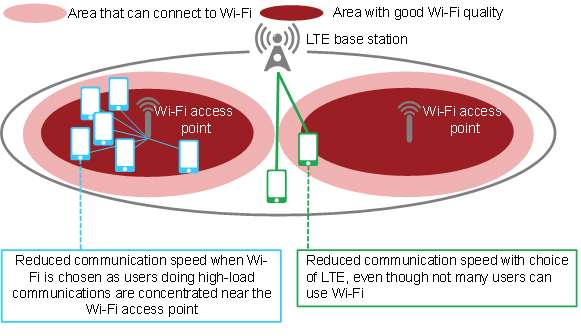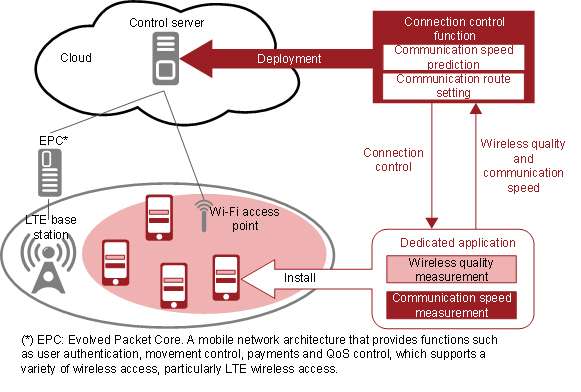Connection control technology for LTE and wi-fi to improve communication speed in wi-fi areas

Fujitsu Laboratories today announced the development of connection control technology for LTE and Wi-Fi to boost communication speed in areas with Wi-Fi. When devices doing high-load communications tasks, such as streaming videos, are concentrated on a single Wi-Fi access point, deterioration in communications speed for each of these devices is a problem. Up to this point, devices have been equipped with technology to enable them to choose a communications route to mitigate communication speed deterioration, such as connecting to LTE instead of Wi-Fi when the Wi-Fi's communication quality is poor. However, as each device determines its communications route independently, without considering the impact on other devices, this can instead cause overall communications speed to decrease.
Fujitsu Laboratories has now developed connection control technology that uses a cloud-based connection control ability to predict communications speed when multiple devices change their connection at the same time, and can automatically set communication routes for multiple devices on the same Wi-Fi access point all at once based on that prediction. As a result of performance evaluations of this technology carried out by changing the distribution of devices using a telecommunications carrier's LTE network, it was confirmed that this technology can increase communications speed by about a factor of two, on average, compared with previous technology. With this technology, mobile users can even more easily make use of services that require high communications speeds, such as videos.
Development Background
In recent years, with the spread of smartphones and tablets, there has been an increase in high-load traffic, such as videos. In addition, Wi-Fi is being expanded, and it is expected that, with the further expansion of areas in which it is possible to use Wi-Fi in the future, users will have more opportunities to enjoy watching videos and using other services while out and about. Current technology allows a large number of users to connect to public Wi-Fi, however, when users who are watching videos or using other high-load communications are concentrated around a single access point, the communications speed can drop, causing situations in which videos stop playing. There is a demand for technology that can avoid this type of situation, without stress on users.
Issues
Currently, several technologies have been applied as methods of improving communications speed for Wi-Fi users, such as a technology that limits reductions in communications speed by having the device autonomously change to connect to LTE, and technologies that limit the number of users that can connect to a Wi-Fi access point. With existing technologies in which each device determines its communications route based on communications quality without considering its impact on other devices, situations could arise that reduce overall communications speed, as when Wi-Fi is chosen even when users doing high-load communications are concentrated around a Wi-Fi access point, or when LTE is chosen even in situations where there are not many users who can use Wi-Fi (Figure 1).
Now Fujitsu Laboratories has developed connection control technology in which a dedicated application is installed on a device that communicates with the connection control function on the control server, which predicts communication speed if multiple devices changed their connection at the same time. It then automatically sets communications routes for multiple devices in a given Wi-Fi service area all at once based on that prediction (Figure 2). Features of the technology are as follows.

1. Technology that estimates the volume of usable wireless resources
With this technology, by installing a dedicated application on a device, the server can control each device, but because devices without the application are also using Wi-Fi and LTE wireless resources, the amount of wireless resources available to controlled devices can change. Therefore, the dedicated application installed on the controlled device first collects information on current communication speeds and wireless quality, and notifies the connection control function on the control server. The connection control function then calculates the communication speed if there were sufficient usable wireless resources from the wireless quality information, and by comparing this with the actual communication speed, estimates the volume of usable wireless resources. This then enables connection control that responds to the situation in that location.
2. Wireless communication route optimization technology
With the connection control function, this technology calculates the predicted communication speed for each controlled device in a Wi-Fi service area using information about the volume of wireless resources that can be used and wireless quality information from controlled devices for each routing pattern, whether each controlled device uses Wi-Fi or LTE for its communication route. Using these results, it chooses the distribution pattern of communication routes that maximizes overall communication speed in the area, and then the connection control function on the control server notifies the dedicated application on each device that corresponds to that pattern, and then carries out switching of the communication route.
Fujitsu Laboratories set up a Wi-Fi access point in a communication area covered by a telecom carrier's LTE network, then placed multiple devices in the area covered by the Wi-Fi access point and measured their communication speeds, both when using existing technology, as in Figure 1, and when using the newly developed connection control technology. Measurements were taken while varying the placement of the devices, and it was confirmed that the new technology could, on average, double communications speed, compared with existing connection control technology. With this technology, services that require high communication speeds, such as streaming video, can be used even more easily in Wi-Fi service areas.
Fujitsu Laboratories aims to conduct even larger-scale field trials using this technology to improve its stability, with the goal of commercializing it in fiscal 2018. Also, Fujitsu Laboratories intends to move forward on expanding functions to enable selection of radio access technologies for 5G, aiming for application from fiscal 2020 onwards.
Provided by Fujitsu





















